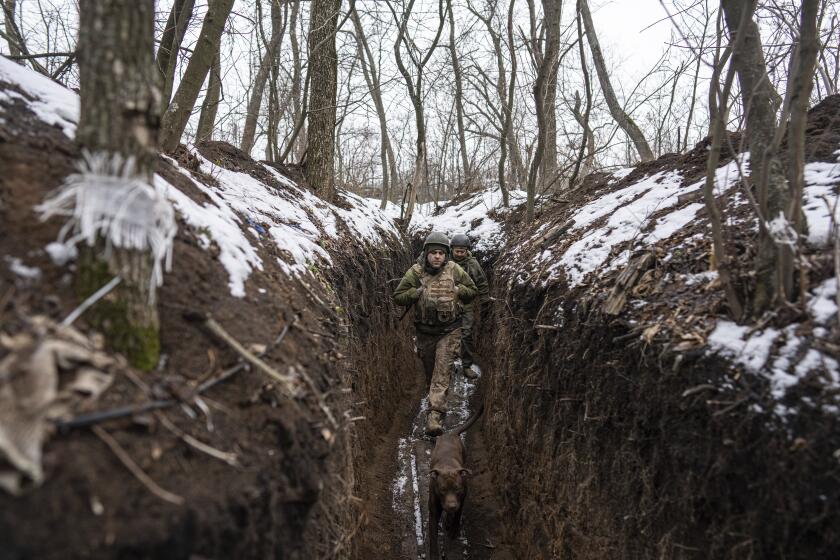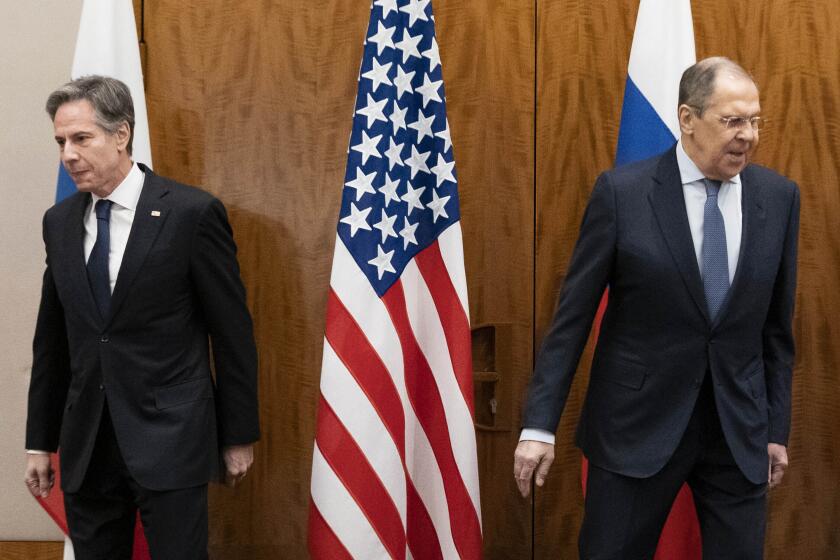Ukraine crisis: What to know as NATO weighs Russia’s actions against its words

- Share via
LONDON — Western fears that a Russian invasion of Ukraine is imminent might have eased slightly but by no means disappeared — especially as the U.S. and NATO say Moscow’s claims of a troop pullback are untrue and that Russia continues to boost its forces along the two countries’ border.
Diplomatic efforts to avert war got new energy this week after Russian President Vladimir Putin said that he was willing to discuss security issues with NATO and that he was withdrawing some of Russia’s troops gathered near Ukraine’s borders. The U.S. and its allies welcomed the diplomatic overture, but say they have seen no evidence of a Russian military de-escalation.
Here’s a look at what is happening where and why:
What’s happening with Russian troops?
Contrary to Putin’s claims, Russia has added as many as 7,000 troops near the Ukrainian border in recent days, a senior Biden administration official said Wednesday. The official was not authorized to speak publicly about sensitive operations and spoke on condition of anonymity. The official did not provide underlying evidence.
President Biden had said Tuesday that 150,000 Russian troops were massed to the north, south and east of Ukraine, and Western officials said a Russian invasion could still happen at the drop of a hat.
U.S. says Russia developed a plan to stage a false attack to help establish a pretext for military action against Ukraine.
Russia’s Defense Ministry has announced that some units participating in military exercises would begin returning to their bases, a statement welcomed as “a good signal” by German Chancellor Olaf Scholz, who met with Putin on Tuesday. The Defense Ministry released footage of a trainload of armored vehicles leaving Crimea, which Russia seized from Ukraine in 2014.
But NATO Secretary-General Jens Stoltenberg said the military alliance had not seen “any signs of de-escalation on the ground — no withdrawals of troops or equipment.”
“Russia maintains a massive invasion force ready to attack,” he said.
What does Russia say?
The Kremlin dismisses warnings that it is planning an invasion. Russian Foreign Minister Sergey Lavrov said Western “hysteria ... profoundly puzzles us,” and accused the West of trying to dictate how Russia should behave on its own territory.
Moscow’s ambassador to the European Union, Vladimir Chizhov, told the German daily newspaper Welt that “there won’t be an attack this Wednesday. There won’t be an escalation next week either, or in the week after, or in the coming month.”
Western officials say that even if an invasion is not imminent, Russia could keep troops massed near Ukraine for weeks, turning the military buildup into a protracted crisis that has already harmed Ukraine’s economy.
With Russian troops just miles away, the residents of a small Ukrainian village wonder if a possible invasion has its sights set on them.
Russian forces kept up their massive war games Wednesday in Belarus, to the north of Ukraine, with fighter jets flying training missions and paratroopers holding shooting drills.
The West fears those exercises could be used as cover ahead of an invasion of Ukraine, but Belarusian Foreign Minister Vladimir Makei said all Russian troops and weapons would leave the country after the maneuvers wrap up Sunday.
What is NATO doing?
Defense ministers from NATO member nations met in Brussels to try to bolster the deterrence side of its twin-track deterrence and diplomacy strategy regarding Russia.
Stoltenberg said NATO would “convey a very clear message to Russia that we are ready to sit down and discuss with them, but at the same time, we are prepared for the worst.”
He said Russia’s actions had provoked “a crisis in European security” and showed that Moscow was willing to undermine the pillars of the continent’s stability by threatening its neighbor.
“I regret to say that this is the new normal in Europe,” he said.
Western embassies are also moving some of their staff out of Kyiv
Stoltenberg said NATO had discussed setting up new battle groups in Central, Eastern and Southeast Europe, including one led by France in Romania, but a final decision has not been made.
NATO has ruled out sending troops to fight Russia in Ukraine, which is not a member of the alliance. But hundreds of U.S., British and other NATO troops have been sent to bolster the defenses of Eastern European member countries, including Poland and the Baltic states, that fear they may also be Russian targets.
Moscow accuses NATO of moving ever closer to Russia’s borders. A key Russian demand is that Ukraine drop its ambition to join NATO. The alliance says Ukraine must have the freedom to make its own choices.
European Union leaders are to discuss the latest developments in the crisis on Thursday before the start of an EU-Africa summit. The bloc, the U.S. and Britain have all threatened heavy sanctions on Russia if it invades.
What else is the West worried about?
Western diplomats have called the crisis the biggest challenge to the international order since the end of the Cold War. It also has focused the attention of many European governments on the security of their future energy supplies.
Western governments accuse Russia of cutting back on its natural gas supplies to Europe to leverage Moscow’s security demands, contributing to months of sharply higher energy prices.
The Russia-Ukraine crisis offers a lesson: The U.S. is still a superpower, but its ability to influence events overseas is increasingly limited.
In the short term, Europe is seeking extra gas from other nations, including Japan. The crisis may also hasten a switch to climate-friendly renewable energy that is already underway.
In the U.S., Biden is warning that gasoline prices could rise if Putin chooses to invade. Inflation has become an albatross for Democrats going into the 2022 midterm elections, despite the nation’s strong economic growth last year.
The cost of crude oil — and gasoline— began to climb over the past month as Putin massed forces on the Ukrainian border. Forecasts from JP Morgan and other investment firms suggest that crude oil — already at about $95 a barrel — could exceed $125 a barrel from tight supplies.
U.S. climate envoy John Kerry will underscore the connection between climate efforts and global security at the Munich Security Conference in Germany, where he is scheduled to speak Friday. Secretary of State Antony J. Blinken also is expected to attend the security event.
What about cyberattacks?
Disruption continued from a cyberattack that knocked out the websites of the Ukrainian army, the defense ministry and major banks in Ukraine on Tuesday. Ukrainian officials say they are investigating the origin of the distributed-denial-of-service attacks. Russia has denied involvement.
Meanwhile, U.S. authorities issued a warning that hackers backed by the Russian state have waged a long-running campaign to get classified material from private contractors working for the Pentagon.
Breaking News
Get breaking news, investigations, analysis and more signature journalism from the Los Angeles Times in your inbox.
You may occasionally receive promotional content from the Los Angeles Times.
The warning issued jointly by the Department of Homeland Security’s cyber unit, the FBI and National Security Agency said the hackers, using “common but effective tactics,” have been targeting defense contractors since at least January 2020 and will likely continue to do so.
What is the mood in Ukraine?
Ukrainian President Volodymyr Zelensky declared Wednesday a “day of national unity.” He called on citizens to display the blue-and-yellow national flag and to sing the national anthem in the face of “hybrid threats.” To mark the day, demonstrators unfolded a 200-yard-long national flag at a sports arena in Kyiv, Ukraine’s capital.
“Russia will not leave us in peace — that’s why we have to be always ready for it,” Yuri Maistrenko, 52, a scientist in Kyiv, said. “It did not start today, but it could tomorrow or after a month.”
What is happening in Russia?
Putin, who has had meetings with French President Emmanuel Macron and Germany’s Scholz in recent days, was all smiles Wednesday when he met Brazilian President Jair Bolsonaro in Moscow.
Russian lawmakers have urged Putin to recognize as independent states the rebel-held areas in eastern Ukraine where Russia has supported separatists in a conflict that has killed more than 14,000 people since 2014. Putin signaled that he wasn’t inclined to back the motion, which would effectively shatter a 2015 peace deal.
Blinken said if Putin did approve the appeal, it would be “a gross violation of international law” and bring “a swift and firm response” from the U.S. and its allies.
Some Ukrainians are starting to wonder whether their neophyte leader has the smarts and strength to lead them through a moment of peril.
What’s the impact further afield?
The crisis is causing ripples in the skies and seas.
Ukraine International Airlines said it has sent some of its passenger planes to Spain “for safekeeping.” The airline said it took the decision under pressure from insurance companies “due to the foreign policy situation.”
The airport at Castellón in eastern Spain said five planes had arrived, with a sixth expected.
The Ukrainian airline continues to operate flights to and from the country with a reduced fleet.
The Cockpit union, which represents pilots in Germany, called for planes to avoid flying over “regions of tension” in eastern Ukraine.
In 2014, 298 people aboard a Malaysia Airlines flight from Amsterdam to Kuala Lumpur were killed when the Boeing 777 was brought down by a missile over rebel-held eastern Ukraine.
Norwegian fishermen, meanwhile, were upset over a three-day Russian naval drill in the Arctic that started Wednesday. Fishing boats are being warned away from a zone about 620 miles long north of Norway — a situation Sturla Roald of the Norwegian Fishing Vessel Owners Assn. called “totally unsustainable.”
More to Read
Sign up for Essential California
The most important California stories and recommendations in your inbox every morning.
You may occasionally receive promotional content from the Los Angeles Times.


















